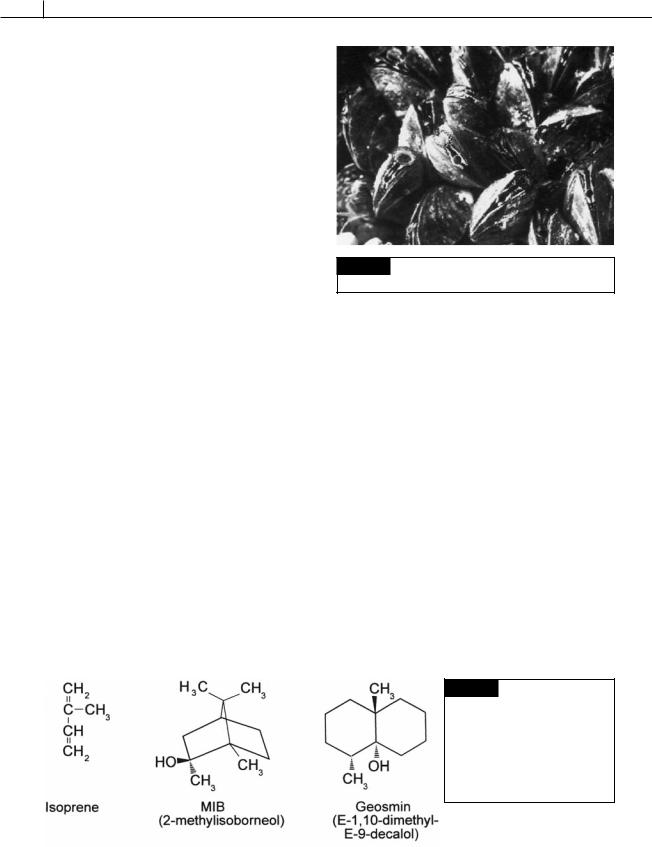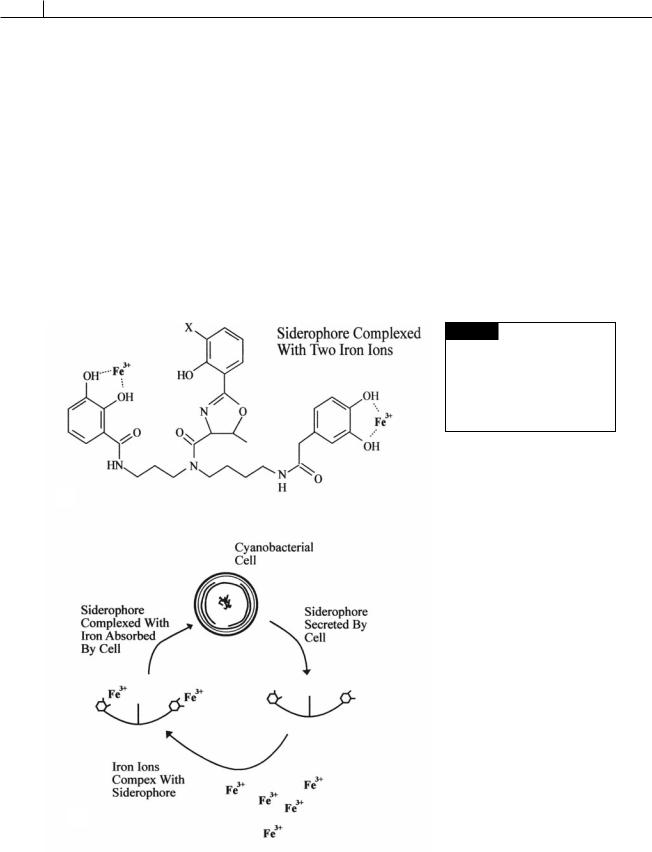
- •Contents
- •Preface to the first edition
- •Flagella
- •Cell walls and mucilages
- •Plastids
- •Mitochondria and peroxisomes
- •Division of chloroplasts and mitochondria
- •Storage products
- •Contractile vacuoles
- •Nutrition
- •Gene sequencing and algal systematics
- •Classification
- •Algae and the fossil record
- •REFERENCES
- •CYANOPHYCEAE
- •Morphology
- •Cell wall and gliding
- •Pili and twitching
- •Sheaths
- •Protoplasmic structure
- •Gas vacuoles
- •Pigments and photosynthesis
- •Akinetes
- •Heterocysts
- •Nitrogen fixation
- •Asexual reproduction
- •Growth and metabolism
- •Lack of feedback control of enzyme biosynthesis
- •Symbiosis
- •Extracellular associations
- •Ecology of cyanobacteria
- •Freshwater environment
- •Terrestrial environment
- •Adaption to silting and salinity
- •Cyanotoxins
- •Cyanobacteria and the quality of drinking water
- •Utilization of cyanobacteria as food
- •Cyanophages
- •Secretion of antibiotics and siderophores
- •Calcium carbonate deposition and fossil record
- •Chroococcales
- •Classification
- •Oscillatoriales
- •Nostocales
- •REFERENCES
- •REFERENCES
- •REFERENCES
- •RHODOPHYCEAE
- •Cell structure
- •Cell walls
- •Chloroplasts and storage products
- •Pit connections
- •Calcification
- •Secretory cells
- •Iridescence
- •Epiphytes and parasites
- •Defense mechanisms of the red algae
- •Commercial utilization of red algal mucilages
- •Reproductive structures
- •Carpogonium
- •Spermatium
- •Fertilization
- •Meiosporangia and meiospores
- •Asexual spores
- •Spore motility
- •Classification
- •Cyanidiales
- •Porphyridiales
- •Bangiales
- •Acrochaetiales
- •Batrachospermales
- •Nemaliales
- •Corallinales
- •Gelidiales
- •Gracilariales
- •Ceramiales
- •REFERENCES
- •Cell structure
- •Phototaxis and eyespots
- •Asexual reproduction
- •Sexual reproduction
- •Classification
- •Position of flagella in cells
- •Flagellar roots
- •Multilayered structure
- •Occurrence of scales or a wall on the motile cells
- •Cell division
- •Superoxide dismutase
- •Prasinophyceae
- •Charophyceae
- •Classification
- •Klebsormidiales
- •Zygnematales
- •Coleochaetales
- •Charales
- •Ulvophyceae
- •Classification
- •Ulotrichales
- •Ulvales
- •Cladophorales
- •Dasycladales
- •Caulerpales
- •Siphonocladales
- •Chlorophyceae
- •Classification
- •Volvocales
- •Tetrasporales
- •Prasiolales
- •Chlorellales
- •Trebouxiales
- •Sphaeropleales
- •Chlorosarcinales
- •Chaetophorales
- •Oedogoniales
- •REFERENCES
- •REFERENCES
- •EUGLENOPHYCEAE
- •Nucleus and nuclear division
- •Eyespot, paraflagellar swelling, and phototaxis
- •Muciferous bodies and extracellular structures
- •Chloroplasts and storage products
- •Nutrition
- •Classification
- •Heteronematales
- •Eutreptiales
- •Euglenales
- •REFERENCES
- •DINOPHYCEAE
- •Cell structure
- •Theca
- •Scales
- •Flagella
- •Pusule
- •Chloroplasts and pigments
- •Phototaxis and eyespots
- •Nucleus
- •Projectiles
- •Accumulation body
- •Resting spores or cysts or hypnospores and fossil Dinophyceae
- •Toxins
- •Dinoflagellates and oil and coal deposits
- •Bioluminescence
- •Rhythms
- •Heterotrophic dinoflagellates
- •Direct engulfment of prey
- •Peduncle feeding
- •Symbiotic dinoflagellates
- •Classification
- •Prorocentrales
- •Dinophysiales
- •Peridiniales
- •Gymnodiniales
- •REFERENCES
- •REFERENCES
- •Chlorarachniophyta
- •REFERENCES
- •CRYPTOPHYCEAE
- •Cell structure
- •Ecology
- •Symbiotic associations
- •Classification
- •Goniomonadales
- •Cryptomonadales
- •Chroomonadales
- •REFERENCES
- •CHRYSOPHYCEAE
- •Cell structure
- •Flagella and eyespot
- •Internal organelles
- •Extracellular deposits
- •Statospores
- •Nutrition
- •Ecology
- •Classification
- •Chromulinales
- •Parmales
- •Chrysomeridales
- •REFERENCES
- •SYNUROPHYCEAE
- •Classification
- •REFERENCES
- •EUSTIGMATOPHYCEAE
- •REFERENCES
- •PINGUIOPHYCEAE
- •REFERENCES
- •DICTYOCHOPHYCEAE
- •Classification
- •Rhizochromulinales
- •Pedinellales
- •Dictyocales
- •REFERENCES
- •PELAGOPHYCEAE
- •REFERENCES
- •BOLIDOPHYCEAE
- •REFERENCE
- •BACILLARIOPHYCEAE
- •Cell structure
- •Cell wall
- •Cell division and the formation of the new wall
- •Extracellular mucilage, biolfouling, and gliding
- •Motility
- •Plastids and storage products
- •Resting spores and resting cells
- •Auxospores
- •Rhythmic phenomena
- •Physiology
- •Chemical defense against predation
- •Ecology
- •Marine environment
- •Freshwater environment
- •Fossil diatoms
- •Classification
- •Biddulphiales
- •Bacillariales
- •REFERENCES
- •RAPHIDOPHYCEAE
- •REFERENCES
- •XANTHOPHYCEAE
- •Cell structure
- •Cell wall
- •Chloroplasts and food reserves
- •Asexual reproduction
- •Sexual reproduction
- •Mischococcales
- •Tribonematales
- •Botrydiales
- •Vaucheriales
- •REFERENCES
- •PHAEOTHAMNIOPHYCEAE
- •REFERENCES
- •PHAEOPHYCEAE
- •Cell structure
- •Cell walls
- •Flagella and eyespot
- •Chloroplasts and photosynthesis
- •Phlorotannins and physodes
- •Life history
- •Classification
- •Dictyotales
- •Sphacelariales
- •Cutleriales
- •Desmarestiales
- •Ectocarpales
- •Laminariales
- •Fucales
- •REFERENCES
- •PRYMNESIOPHYCEAE
- •Cell structure
- •Flagella
- •Haptonema
- •Chloroplasts
- •Other cytoplasmic structures
- •Scales and coccoliths
- •Toxins
- •Classification
- •Prymnesiales
- •Pavlovales
- •REFERENCES
- •Toxic algae
- •Toxic algae and the end-Permian extinction
- •Cooling of the Earth, cloud condensation nuclei, and DMSP
- •Chemical defense mechanisms of algae
- •The Antarctic and Southern Ocean
- •The grand experiment
- •Antarctic lakes as a model for life on the planet Mars or Jupiter’s moon Europa
- •Ultraviolet radiation, the ozone hole, and sunscreens produced by algae
- •Hydrogen fuel cells and hydrogen gas production by algae
- •REFERENCES
- •Glossary
- •Index

CYANOBACTERIA 65
1Active export of inorganic ions in the protoplasm leading to relatively unchanged
internal salt concentrations.
2Accumulation of organic osmoprotective compounds, such as glucosylglycerol, glycine, and betaine (trimethylglycine) (Fig. 2.47), to maintain the osmotic equilibrium (Ferjani
et al., 2003).
3Expression of a set of salt-stress proteins such as the protein flavodoxin.
Cyanotoxins
Some of the cyanobacteria produce toxins (cyanotoxins). Physiologically, there are basically two types of cyanotoxins: neurotoxins and hepatotoxins (Carmichael, 1992; Bell and Cobb, 1994; Codd et al., 1999).
Neurotoxins – The neurotoxins are alkaloids (nitrogen-containing compounds of low molecular weight) that block transmission of the signal from neuron to neuron and neuron to muscle in animals and man. Symptoms include staggering, muscle twitching, gasping and convulsions. The neurotoxins can be fatal at high concentrations due to respiratory arrest caused by failure of
the muscular diaphragm. The two neurotoxins produced by cyanobacteria are anatoxin and saxitoxin (Fig. 23.3). Anatoxins are synthesized by species of Anabaena (Figs. 2.16, 2.18(d), 2.57(b)),
Aphanizomenon (Fig. 2.18(b)), Oscillatoria (Figs. 2.19(a), (b), 2.34(a), (b)) and Trichodesmium (Figs. 2.31, 2.56(g)) (Negri et al., 1997).
Hepatotoxins – The heptatotoxins are inhibitors of protein phosphatases 1 and 2A (Arment and Carmichael, 1996) and affect the animal by causing bleeding in the liver. Clinical signs include weakness, vomiting, diarrhea, and cold extremities. Cyanobacteria produce two types of hepatotoxins, the microcystins and nodularins (Fig. 23.2), that are produced along a similar pathway (Rinehart et al., 1994). Microcystins are synthesized by species of Microcystis (Figs. 2.48, 2.56(b)), Anabaena (Figs. 2.16, 2.18(d), 2.57(b)), Nostoc (Figs. 2.35, 2.46(b)–(d), 2.57(a)), Nodularia (2.42(a)), and Oscillatoria (Figs. 2.19(a), (b), 2.34(a), (b)) while the nodularins are produced by species of Nodularia (Fig. 2.42(a)) (Kotak et al., 1995; Bolch et al., 1999).
The cyanotoxins are mostly important in freshwaters where the cyanobacteria are ingested in drinking water by animals, with the algae dying and releasing their toxins in the intestinal tracts. The cyanotoxins are responsible for the loss of
Fig. 2.48 Light micrographs of two species of Microcystis.
(From Bittencourt-Oliveira et al., 2001.)

66 THE PROKARYOTIC ALGAE
large numbers of stock each year throughout the world, usually in the warm summer months when the blooms of cyanobacteria are visible in the water. Seldom will man drink from such an unattractive water source. As such, poisoning of man by cyanotoxins is relatively rare, partly because of the odor from geosmin and MIB (Fig. 2.50) produced by cyanobacteria.
The cyanotoxins function as anti-herbivore chemicals by inhibiting invertebrate grazers in the aquatic environment. Grazing by invertebrates causes Microcystis aeroginosa (Figs. 2.48, 2.56(b)) to increase production of cyanotoxin (Jang et al., 2003). Cyanotoxins also can inhibit the growth of other algae. This is called an allelopathic interaction where one organism affects the growth of a second organism. An example of this is the inhibition of the freshwater dinoflagellate Peridinium gatunense by the microcystin produced by the cyanobacterium Microcystis (Figs. 2.48, 2.56) in Lake Kinneret (Sea of Galilee), Israel. The Microcystis cyanotoxins abolish carbonic anhydrase activity in the dinoflagellate and inhibit growth (Sukenik et al., 2002). The microcystin is classified as an allelochemical and acts as an algicide.
Another allelopathic interaction involves the zebra mussel (Dreissena polymorpha) (Fig. 2.49) and the cyanobacterium Microcystis. Zebra mussels, native to the Black and Caspian seas, were discovered in the United States near Detroit in 1988. Since then zebra mussels have spread throughout the Great Lakes of North America, displacing native shellfish. The zebra mussel has been beneficial in low-nutrient lakes (but not in lakes high in nutrients) because they graze on Microcystis, probably because the mussels have nothing else to eat (Raikow et al., 2004).
Fig. 2.49 Zebra mussels; each mussel is about the size of a
pistachio nut.
Cyanobacteria and the quality of drinking water
Geosmin (E-1,10-dimethyl-E-9-decalol) and MIB (2-methylisoborneol) (Fig. 2.50) are two terpenoids (isoprenoids) that are produced by some cyanobacteria (Watson, 2003). These terpenoids are called volatile organic compounds (VOCs), have a highly potent earthy, musty or muddy aroma and account for most of the odors in drinking water. They have odor threshold concentrations of 10 ng l 1. Terpenoids as a class have extensive olfactory properties, which are exploited commercially in the food, beverage, and perfume industries. Both geosmin and MIB resist conventional water treatment, and their bioaccumulation in fish and shellfish causes off-flavor in farmed and wild stocks. Neither geosmin nor MIB are toxic to vertebrates (including humans). The low incidence of human
Fig. 2.50 The chemical structure of the terpenoids MIB and geosmin. The terpenoids are constructed of multiples of 5-carbon isoprene or 2-methyl-1,3 butadiene. Terpenoids containing three isoprene units (e.g., MIB and geosmin) are called sesquiterpenoids.

CYANOBACTERIA 67
poisonings by cyanotoxins has been attributed to the avoidance of water containing cyanobacteria because of the odors produced by geosmin and MIB. Both compounds are commonly found in freshwater and solid habitats, but are rare in offshore marine environments, and can be used as landmass indicators. These volatile organic compounds produced by cyanobacteria act as infochemicals by attracting nematodes to cyanobacterial colonies where the nematodes feed and deposit eggs (Hockelmann et al., 2004).
Utilization of cyanobacteria as food
Cyanobacteria are used as human food and animal food supplements (Belay et al., 1966). In China, the Spirulina (Figs. 2.51, 2.56(f )) industry is supported by the State Science and Technology Commission as a natural strategic program (Li and Qi, 1997). In 1996 there were more than 90 Spirulina factories with a total production of 400 tons of Spirulina dry powder and a total production area of 1 million square meters. Besides Spirulina pills and capsules, there are also pastries, blocks, and Spirulina-filled chocolate blocks.
Nostoc (Figs. 2.46(b), (c), (d)) is a cyanobacterium that has been gathered for food for over two
thousand years in China (Gao and Ye, 2003). It is called “hair vegetable” because of its hair-like appearance. The Chinese word for “hair vegetable” (Facai) sounds like another Chinese word that means fortunate and get rich, adding a spiritual value to the cyanobacterial food.
In Japan, Aphanothece sacrum, Nostoc verrucosum
(Fig. 2.46(d)), N. commune (Fig. 2.46(b), (c)), and Brachytrichia have been used as side dishes since ancient time. Bernal Diaz del Castillo, who accompanied Cortez to Mexico, described in 1521 how people living in the area of Mexico City “sell some small cakes made from a sort of ooze which they get out of a great lake, which curdles and from which they make bread having a flavor something like cheese.”
Aphanizomenon flos-aquae (Fig. 2.18(b)) has been harvested from Klamath Lake in California since the early 1980s and sold as a food and health supplement. In 1998, 10 106 kg (dry weight) was marketed with a value of $100 million (Carmichael et al., 2000). Other cyanobacteria, such as Spirulina (Figs. 2.51, 2.56(f )), are readily available at health-food stores in the developed world, although one wonders how healthy these cyanobacteria really are in regard to the potential for this group of algae to produce cyanotoxins.
Cyanophages
Fig. 2.51 Scanning electron micrograph of Spirulina
platensis. (From El-Bestaway et al., 1996.)
Cyanophages are viruses that infect and commonly kill cyanobacteria (Suttle and Chan, 1994). Cyanophages can be extremely numerous, concentrations in excess of 100 000 viruses have been observed in surface seawater off the coast of Texas. Normally, however, cyanophages occur at concentrations of 1⁄10 that of the cyanobacterial host cells. Most cyanobacteria are actually resistant to attack by cyanophages with the cyanophage population being maintained by infection of the relatively rare cyanobacteria that are susceptible to infection. Cyanobacteria in the open ocean are more susceptible to infection than cyanobacteria from inshore waters. High temperature and phosphate limitation increase the probably of cyanobacterial infection by cyanophages (Wilson et al., 1996).

68 THE PROKARYOTIC ALGAE
Secretion of antibiotics and siderophores
Some cyanobacteria, such as Nostoc (Figs. 2.35, 2.46(b), (c), (d), 2.57(a)) secrete antibiotics called bacteriocins, which kill related strains of the alga (Flores and Wolk, 1986). A bacteriocin is a proteinaceous antibiotic that is active against prokaryotic strains closely related to the organism that produces the antibiotic. Other cyanobacteria secrete antibiotics that are active against a wide range of cyanobacteria and eukaryotic algae. Scytonema hofmanni (Fig. 2.46(e)) produces such an antibiotic (Mason et al., 1982; Gleason and Paulson, 1984). This antibiotic, called
cyanobacterin, is a chlorine-containing -lactone (Pignatello et al., 1983). All of these antibiotics probably play an active role in the survival of the producing organism by inhibiting growth of competing organisms.
The obligate requirement for iron, coupled with the low solubility of iron in many aquatic habitats, has led to the evolution of a mechanism for iron acqusition, at the cost of cellular energy and nutritional stores. A number of cyanobacteria release extracellular ferric-specific chelating agents (“siderophores”) during periods of low iron availability. Siderophores function as extracellular ligands that aid in solubilization and assimilation of Fe3 (Fig. 2.52) (Wilhelm et al., 1996; Barbeau et al., 2003).
Fig. 2.52 (a) A siderophore complexed with two ions of iron. (b) A cyanobacterial cell secretes a siderophore which complexes with iron ions in the medium. The siderophore complexed iron ions are absorbed by the cell.
(a)
(b)
